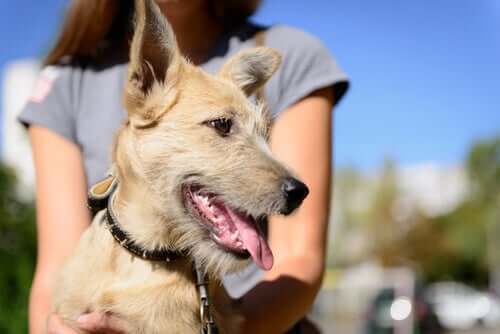Can I Change A Dog's Name?

If you think you’ve given your dog the wrong name or don’t like the name that previous owners gave her, you should know that it’s quite possible to change a dog’s name. In the following article, we’ll tell you what you need to know.
A dog’s name isn’t transcendent

Unlike with humans, a dog or cat’s name isn’t a fundamental part of them. Animals communicate and introduce themselves through their unique smell. They don’t use the name that you’ve had engraved on the tag on their collar.
A dog doesn’t assign any sense of their identity to their name. They also don’t question it. For a dog, their name is just related to following orders. It’s similar to when you say “come” or “no.” Test it out. You can say a different word in the same tone you usually say your dog’s name. You’ll probably see a similar reaction.
In other words, you can change a dog’s name. It’s just like teaching them something new. Many times a dog’s name is used as a way to scold her and has negative associations. That’s why you can call her thousands of times in the park and she’ll run away.
In cases where a pet has been abandoned or abused in the past, veterinarians recommend changing their name. That way you can change the negative associations they have with their name.
You may also want to change a dog’s name to avoid any potential problems. For example, if you adopt a pet that has the same name as a partner or friend, it could get confusing and embarrassing. On the other hand, if you adopt a dog that has a name that doesn’t fit with your lifestyle, it’s better to change it. A religious person, for example, wouldn’t enjoy having a dog called Satan.
How to change a dog’s name when you adopt
It’s common for a new owner to want to change a dog’s name if they didn’t choose the original name. This is the case when you adopt or rescue a dog. You don’t have to like the name that the original owners picked. You also have the right to change it.
The good news is that a new name can sometimes be beneficial for the animal. They get to put aside any negative associations with their ugly past.
For the dog to accept the change, you should take into account certain issues that will facilitate the process. The amount of time the adjustment can take depends on the case, and there are some factors that can influence the adjustment period.
If the dog is elderly or has had the same name for many years, it will probably take a few months for him to respond to his new name. However, it’s never too late for them to learn their new name and recognize it as their own.
On the other hand, if an animal has been mistreated, she may respond quicker to her new name. It won’t have any of the associations that her old name had to shouts or abuse. Here are some tips to change a dog’s name:
1. Choose the new name carefully

It’s not ideal to keep getting tired of the name you choose and repeatedly change it. That many transitions aren’t good for the animal. Use your imagination, but remember that short and simple names are easier for the dog to understand.
2. Practice
When you say tour dog’s new name and she turns around, give her a treat or praise her. That way she’ll learn quickly to respond to her name.
3. Look at your animal in the eyes
The dog should know that he’s being spoken to. In other words, you need to look at the dog right in the eyes when you say his new name. You’ll have to repeat it a bunch of times for the dog to make the association. We also recommend you not to punish him while saying his new name. That way you can avoid the dog relating his name to punishments.
If you think you’ve given your dog the wrong name or don’t like the name that previous owners gave her, you should know that it’s quite possible to change a dog’s name. In the following article, we’ll tell you what you need to know.
A dog’s name isn’t transcendent

Unlike with humans, a dog or cat’s name isn’t a fundamental part of them. Animals communicate and introduce themselves through their unique smell. They don’t use the name that you’ve had engraved on the tag on their collar.
A dog doesn’t assign any sense of their identity to their name. They also don’t question it. For a dog, their name is just related to following orders. It’s similar to when you say “come” or “no.” Test it out. You can say a different word in the same tone you usually say your dog’s name. You’ll probably see a similar reaction.
In other words, you can change a dog’s name. It’s just like teaching them something new. Many times a dog’s name is used as a way to scold her and has negative associations. That’s why you can call her thousands of times in the park and she’ll run away.
In cases where a pet has been abandoned or abused in the past, veterinarians recommend changing their name. That way you can change the negative associations they have with their name.
You may also want to change a dog’s name to avoid any potential problems. For example, if you adopt a pet that has the same name as a partner or friend, it could get confusing and embarrassing. On the other hand, if you adopt a dog that has a name that doesn’t fit with your lifestyle, it’s better to change it. A religious person, for example, wouldn’t enjoy having a dog called Satan.
How to change a dog’s name when you adopt
It’s common for a new owner to want to change a dog’s name if they didn’t choose the original name. This is the case when you adopt or rescue a dog. You don’t have to like the name that the original owners picked. You also have the right to change it.
The good news is that a new name can sometimes be beneficial for the animal. They get to put aside any negative associations with their ugly past.
For the dog to accept the change, you should take into account certain issues that will facilitate the process. The amount of time the adjustment can take depends on the case, and there are some factors that can influence the adjustment period.
If the dog is elderly or has had the same name for many years, it will probably take a few months for him to respond to his new name. However, it’s never too late for them to learn their new name and recognize it as their own.
On the other hand, if an animal has been mistreated, she may respond quicker to her new name. It won’t have any of the associations that her old name had to shouts or abuse. Here are some tips to change a dog’s name:
1. Choose the new name carefully

It’s not ideal to keep getting tired of the name you choose and repeatedly change it. That many transitions aren’t good for the animal. Use your imagination, but remember that short and simple names are easier for the dog to understand.
2. Practice
When you say tour dog’s new name and she turns around, give her a treat or praise her. That way she’ll learn quickly to respond to her name.
3. Look at your animal in the eyes
The dog should know that he’s being spoken to. In other words, you need to look at the dog right in the eyes when you say his new name. You’ll have to repeat it a bunch of times for the dog to make the association. We also recommend you not to punish him while saying his new name. That way you can avoid the dog relating his name to punishments.
This text is provided for informational purposes only and does not replace consultation with a professional. If in doubt, consult your specialist.








